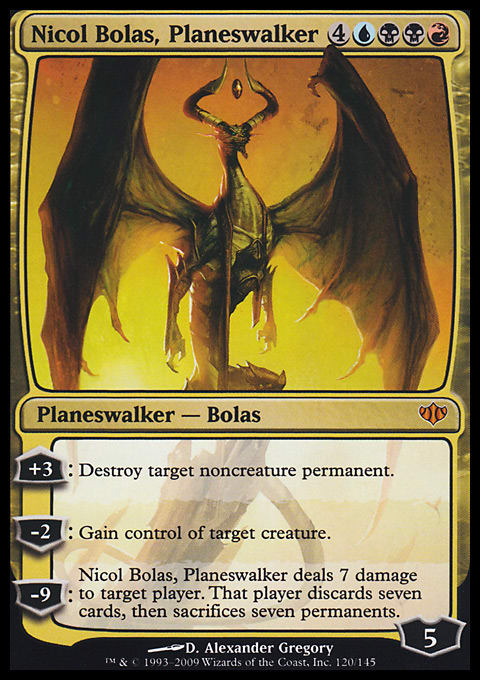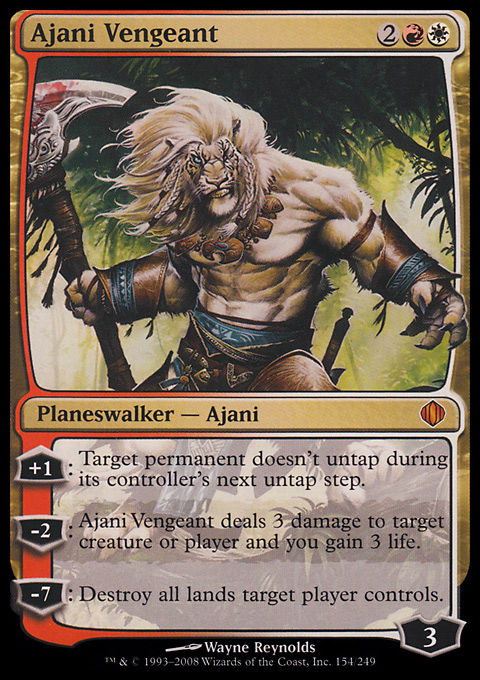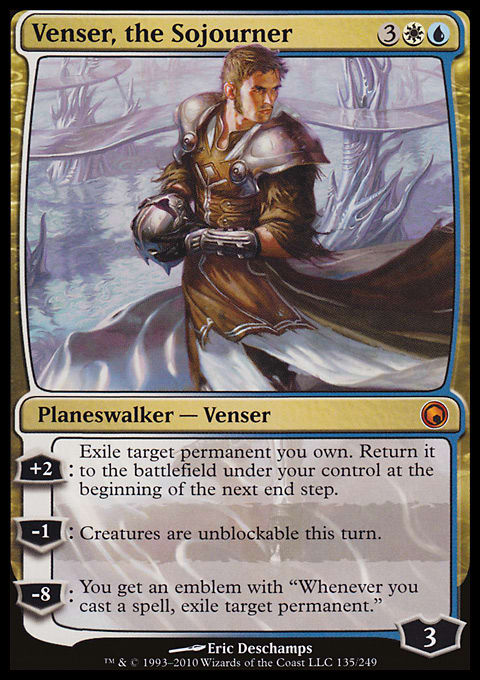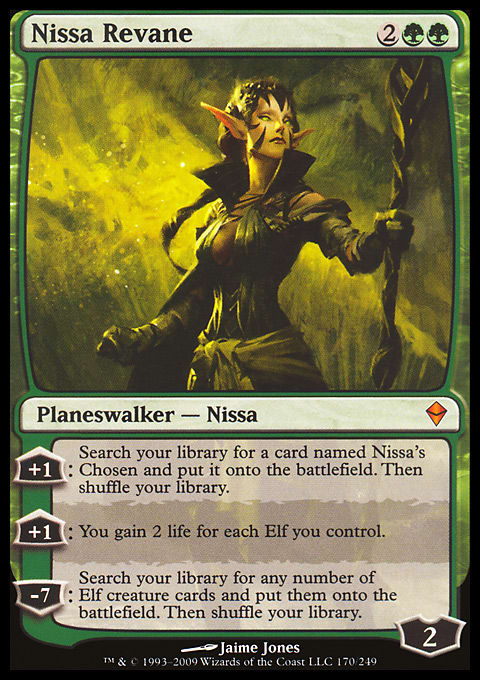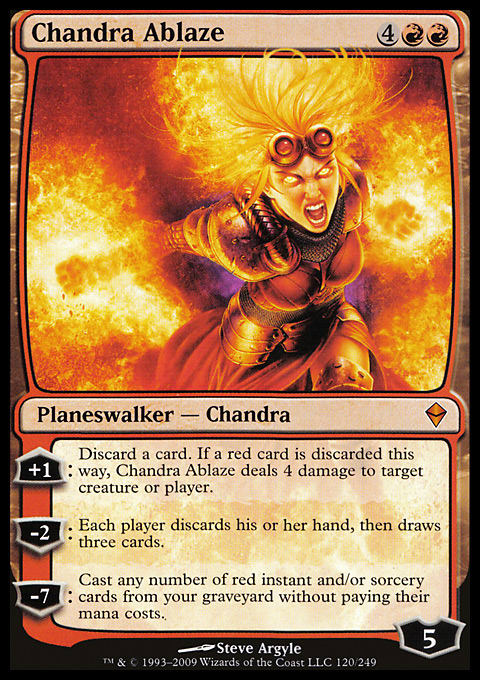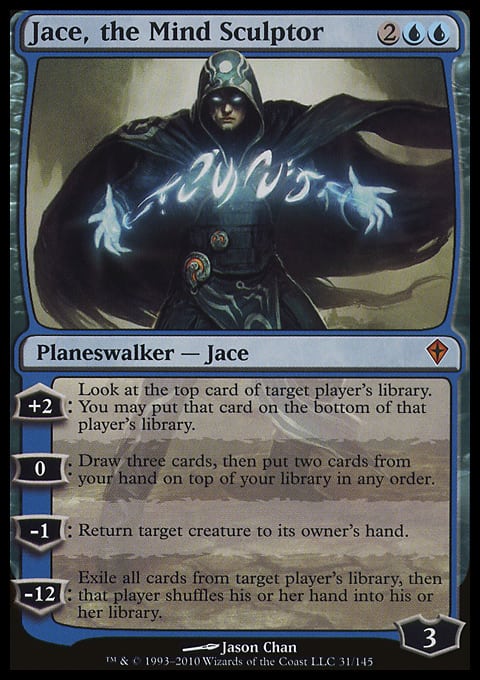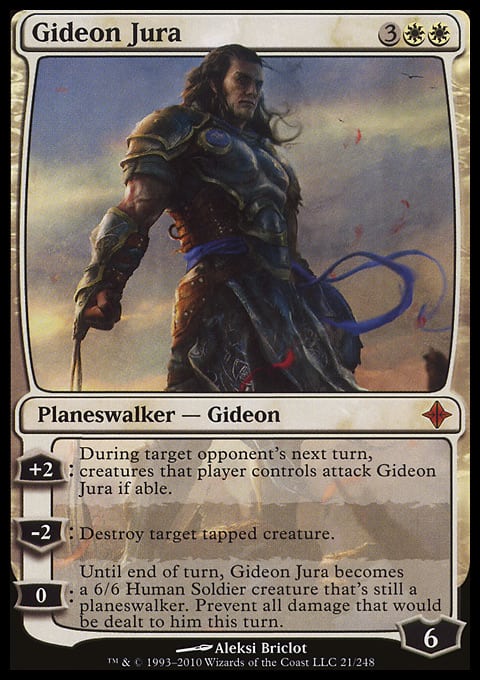I decided to try something a bit different this week: a Vorthos–Melvin blend. For those unfamiliar with the terms, they’re nicknames given to two types of card appreciators. Melvin is the armchair designer who likes picking apart game mechanics and analyzing cleverly composed cards. Vorthos is the story guy who likes the flavor of the game and the various plots and histories. Today, I’ll be using both perspectives to talk about Magic’s most controversial card type: planeswalkers.
I fell in love with planeswalkers immediately when they were first spoiled. The mechanics were gorgeously designed—Aleksi Briclot nailed the art—and they gave a gameplay face to a critical part of the Magic story. All in all, I consider them to be a home-fun success.
Awesome Planeswalker Designs
Bolas is, in short, jaw-droppingly awesome. He’s a freakin’ DRAGON PLANESWALKER. Even if you’re opening your very first pack of Magic cards, you see him, and you know you’ve found something special. If you’re a long-time player, you’ll recognize a classic character and appreciate the connections to the original legend. I love everything about this card—the abilities, the art, even the mana cost. The brevity of his first two abilities really emphasizes their power, and the wordiness of the third manages the same effect in a completely different way.
I always thought Nicol Bolas would be the perfect choice for the first multicolored card in a core set. He really makes that gold border feel special. When this video was released, I was sure we’d see Bolas in Magic 2012. I was disappointed that round, but it looks like Magic’s greatest villain will be making a high-profile return in Magic 2013. I know I’m excited.
Ajani Vengeant is on the opposite end of the spectrum. When you first see the card, his abilities seem completely random. They have nothing to do with each other, and there’s no particular connection to vengeance. It’s cool that he’s casting a distinct and iconic spell in the form of Lightning Helix, but why would this card make my list?
The answer is that Ajani Vengeant is an awesome card to play with. His abilities look arbitrary, but when you actually play with him, they fit together perfectly. Against control, he disrupts mana while threatening land destruction; or he throws damage to the face. Against aggro, he forces the opponent to overcommit into Wraths or he just kills a guy and gains some life. I played four copies for most of his life in Standard, and I still play him in Cube every chance I have.
Venser is an excellent mix of gameplay and flavor. He’s easily the best Johnny planeswalker to date—he’s powerful, but he’s a puzzle you have to solve. People see him and want to build decks around him. Additionally, he really manages to capture the flavor of a teleportation specialist with his abilities. Looking like the good doctor doesn’t hurt either.
Speaking of Venser . . .
Death of a Planeswalker
As planeswalkers became the new face of Magic, I came to wonder when and if Wizards would have the guts to kill one off. After all, this is a game about deadly conflict, and it seemed inevitable that one of the major characters should kick the bucket.
My question was answered last year with the return to Mirrodin. The concept was solid—Venser is dying of his addiction to a power-enhancing drug, and he sacrifices himself to save his old friend and mentor Karn from Phyrexian corruption. Venser is redeemed, and his sacrifice is a major victory for the good guys.
The problem is how it was handled. The death of a planeswalker should be a major, ground-shaking event. Venser’s death wasn’t shown in any piece of art or mentioned in any flavor text. It doesn’t even show up in his bio on the official Wizards site. Heck, he got a Duel Deck a year after his demise. How’s that for establishing the significance of a character’s death?
I hope that this isn’t the last time they kill a major character, and I hope that next time it’s handled with a little more aplomb. At least give the event art and flavor text on a notable card.
Questionable Planeswalker Designs
Sarkhan was the first planeswalker people were really disappointed with. I mean, he was exciting—his ultimate makes 20 power worth of Dragons! But he didn’t have any way to defend himself, and his first two abilities just weren’t good enough.
I actually think he could have been good in the right context, though. He spent the first half of his time in Standard fighting Faeries and five-color control and the second half competing with Bloodbraid Elf at the same mana cost. But imagine if he had arrived a year later, during the time of Titans and Valakut ramp. In the end, I think he’s a solid design who got a bad reputation from hype and circumstances of the metagame.
Including Nissa may be more because of my personal dislike than a general failure of the design. I think what kills the design for me is the first ability referencing Nissa's Chosen. Naming and requiring other specific cards isn’t used very often in Magic, and for good reason. I’m okay with it on silly gimmick cards like Arachnus Spinner or Dark Supplicant, but I’m not a fan on a flagship card like a planeswalker.
First of all, it makes Nissa impossible to evaluate if you haven’t seen what Nissa's Chosen is. If could be a 1/1 or a 10/10 for all you know. What’s more, Nissa's Chosen is a pretty mediocre card, so our sweet planeswalker forces us to make the feel-bad decision of running crappy creatures to support her. Would it have been so bad for her to just make a 2/2 token?
Now, if I were to pick a single planeswalker as a failure, I would pick Chandra Ablaze. Either the 6-mana cost or the discard requirement would have hurt her, but the combination of the two was a death sentence. She was both underpowered and unappealing. She’s not completely useless—I was elated to see her played in an old Extended Dragon stompy deck, and her −2 ability can be solid in multiplayer. But overall, she’s not a high point of planeswalker design.
On the other end of the power spectrum, we have Big Jace. He’s the most powerful planeswalker to date, the most expensive Standard-legal card of all time, and the first card to be banned in Standard in over five years. He was designed to be a powerful face of Magic, but he was pushed just a little too far.
He’s an awesome-looking card, though, and a lot of fun to play. I think the core of the design is really solid. I wonder what tweaks it would have taken to drop the power level back into acceptable ranges.
It’s worth noting how many of the more problematic designs come from Zendikar block. This was the first time that they really started experimenting with the planeswalker formula. We had planeswalker abilities with additional costs, 0-mana abilities, and our first departures from the plus-minus-ultimate scheme. I think it was an important period that showed which rules could be broken and which shouldn’t, and it has led to more varied and successful designs since.
LGBT Planeswalkers
A while back, someone posted on Mark Rosewater’s tumblr sharing a displeasure with the efforts Magic makes regarding racial diversity and the portrayal of women and asking if Wizards had considered any LGBT characters. (For those not in the know, LGBT stands for Lesbian, Gay, Bisexual, and Transgender. It is frequently supplemented by additional letters.) Mark’s response was basically, “How do you know we don’t have gay characters? Which ones would you guess?”
(I apologize for the lack of direct quotes—MaRo answers so many questions per day that I dug through fifty pages without finding this specific question.)
Mark’s response is flippant and a bit evasive, but I thought it was a reasonable point. Romance is not a huge part of the Magic story, and without it, there’s not any reason to assume a particular orientation. Moreover, I found it an interesting thought experiment: If I were in charge, how would I make these decisions?
Writing characters of any minority or controversial group is a complex affair. You don’t want to offend people or perpetuate stereotypes, but it’s all too easy to fall into the positive discrimination trap in which you write minority characters as flawless beings rather than actual people. Hopefully someday, media will have enough balanced portrayals that we can just write whatever characters we want without worrying about unfortunate implications, but for now, it pays to be a bit careful.
It can be pretty eye-opening to see how careful you need to be, though. Let’s imagine I wanted to write one of the original Lorwyn five as LGBT. Jace is an emo pretty-boy, Chandra’s a rebellious teenager, Garruk is an egotistical outcast, Ajani is a vengeful cat-person, and Liliana is pretty much an incarnation of evil female sexuality. There’s literally no way to write a minority character who won’t piss someone off, but I’d rather see writers go for a careful portrayal than avoid them entirely out of fear.
Anyway, after a certain amount of consideration, here are the planeswalkers I would write as LGBT given the opportunity. I will consider it part of my personal canon until proven otherwise.
Gideon is lawful good to a fault. Did you watch the video with him I linked earlier? He’s gone from knight templar to atoner, and he goes toe-to-toe with Eldrazi and Nicol Bolas. He seems to have a canonical interest in Chandra, so I suppose he’d have to be bi. All the better—there aren’t many portrayals of bisexual men in media, let alone positive ones.
Tamiyo, on the other hand, is the best of true neutral. I think Tamiyo is awesome—she watches a world fall into darkness and be overtaken by monsters, then be restored by an archangel who changes the fabric of magic itself. Her response is to excitedly take notes. She’s a geeky wanderer with some substantial power who would much rather use it for study than combat.
Core Set Planeswalkers
Core sets have an interesting relationship with planeswalker cards. A single core set has as many as an entire block, but they’re in Standard for half the amount of time. You’re trying to establish some sense of continuity with recurring characters, but you don’t want the same powerful cards to define Standard year after year.
Magic 2010 and Magic 2011 both reprinted the original Lorwyn five, which worked well as a starting point, but they were pretty unexciting after their third printing. Magic 2012 shook things up by reprinting two planeswalkers from expert-level expansions and introducing completely new card versions of the other three Lorwyn ’walkers.
I think core sets are a good place to show character development through new versions, but a lack of multicolored cards makes this hard. Two blue Jaces are largely interchangeable character-wise, but a W/B Sorin is markedly different than a mono-black Sorin. A complete color shift (say, a red Garruk) will often feel radical, and it hasn’t yet been used.
I don’t think the presence of Nicol Bolas, Planeswalker in the core set will or should herald an immediate change in multicolored policy. I would much rather see very limited representation for now. But maybe around Magic 2015, we’ll start seeing things like a cycle of allied-colored planeswalkers.
Signing Off
This has been a pretty radical departure from my previous articles, and I’m curious to hear what people think. Is it fun to see my analytical perspective turned to more abstract subjects, or would you prefer I stick to strategy and design? Let me know in the comments!
















